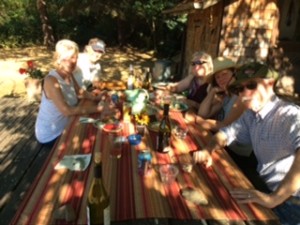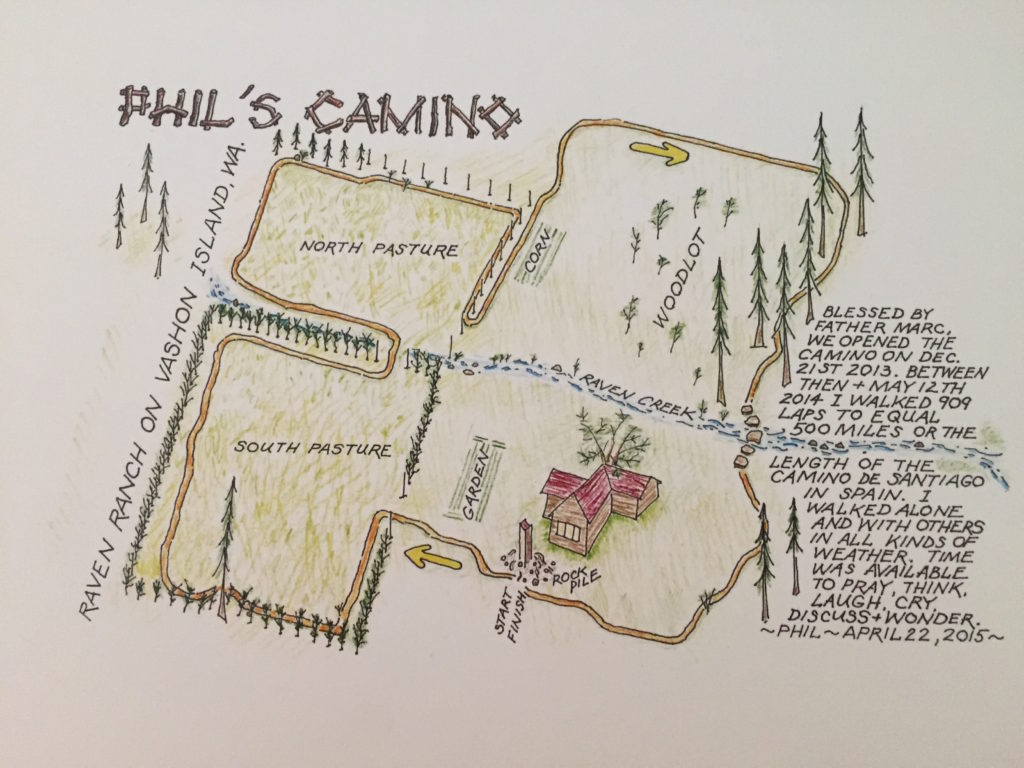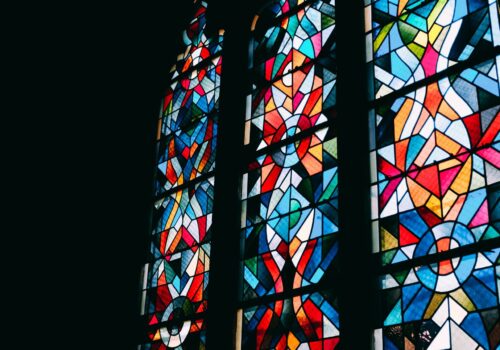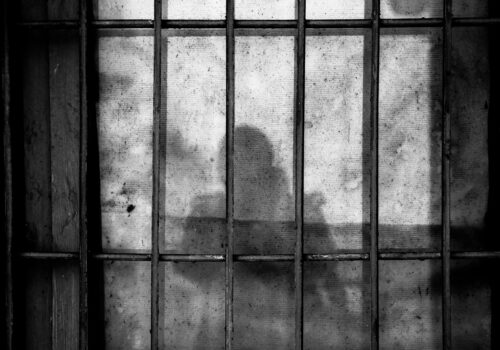Download PDF: Barush, The Root of the Route
Abstract
On a rainy day on an island in the Pacific Northwest, Phil Volker walked along the well-known, and well-trodden half-mile path in his own 10-acre backyard. The damp earth sprung beneath his boots as he chatted amiably to his companions. Although he had been walking for miles and miles along the circuit, today was a special day, as he had made it to Burgos. Or, at least, the distance to Burgos – a town along the ancient pilgrimage route to the Cathedral of Santiago de Compostela (known as theCamino – or Way – of St. James). After a cancer diagnosis had thwarted his dreams of traveling to Spain, Phil had mapped all 500 miles of the pilgrimage onto his own backyard, and today was just one stop along his circuitous journey. Phil’s Camino project is explored here within the Catholic tradition of surrogate pilgrimages in the forms of labyrinths, the Via Crucis, and other media, usually undertaken by those who could not travel for a variety of reasons, including economic hardship or, like Phil, ill health. The sacred trail that he mapped on to his own property will be considered as a work of art in the form of a built environment which retains a trace of the original Camino de Santiago, and, like the Camino de Santiago, continues to function as a place of healing and renewal for Phil and for the pilgrims who have joined him as he continues to traverse the Way.
On a hand-drawn map of his 10-acre property on Vashon Island in the Pacific Northwest, Phil Volker has labeled, in gently sloping capital letters, the north and south pastures, the garden and the corn patch, the woodlot and Raven Creek.[1] Yellow arrows point the way along a path bordered by towering fir trees and smaller hardwoods; at one point, five irregular stones bridge the creek and a rock pile marks the start and finish. It is a path he has walked many times, and with many companions. On the right side, the same lettering explains:
Blessed by Father Marc, we opened the Camino on Dec. 21st 2013. Between then + May 12th 2014 I walked 909 laps to equal 500 miles or the length of the Camino de Santiago in Spain. I walked alone and with others in all kinds of weather. Time was available to pray, think, laugh, cry, discuss + wonder.[2]
After a cancer diagnosis thwarted Phil’s dreams of walking the ancient Camino de Santiago to Compostela in Spain, he did the next best thing; that is, he mapped the entire route onto his own backyard.[3]
Phil’s Camino project will be explored here within the Catholic tradition of surrogate pilgrimages in the forms of labyrinths, the Via Crucis, and other media, usually undertaken by those who could not travel for a variety of reasons, including economic hardship or, like Phil, ill health.[4] The sacred trail that he mapped on to his own property will be considered as a work of art; in this case, it is a built environment which retains a trace of the original Camino de Santiago, and, like the Camino de Santiago, continues to function as a place of healing and renewal for Phil and for the pilgrims who have joined him as he continues to traverse the Way. It is crucial to include a diversity of visual media alongside textual discourse as scholars from a number of fields (including my own area of art history and religious studies along with theology, anthropology, and sociology) proceed towards a more developed framework for considering art and religion, as well as a critical lexicon for discussing the efficacy of objects. Phil’s Camino will be examined here as a case study through which to develop the notion of the transfer of ‘spirit’ from sacred site to representation, while acknowledging the historical roots of surrogate pilgrimages within Catholic devotional practices and popular piety which the project engenders.

When Phil reached his backyard Burgos, an important town along the French Camino route, he sat at a picnic table laden with tapas and wine, mirroring the pilgrim meals along the Camino across the sea. Although seemingly far away, it is the salty sea which links Vashon Island off of Seattle, which Phil calls home, to the Galician Coast where the remains of Saint James the Greater, son of Zebedee, were said to have washed up in biblical times. He had ceased his work as a successful fisherman to follow Jesus. According to an ancient legend, Saint James traveled to Spain to preach the Gospel. Upon completing a period of ministry and mission there, he returned to Judea and was put to death at King Herod’s orders. After his martyrdom, two of his own disciples transported his body to shore where they found a miraculous boat which conveyed his remains back to Spain. By the 12th century, Santiago de Compostela was a flourishing center of pilgrimage, only surpassed in popularity and importance by Rome and Jerusalem. Many made the arduous physical and spiritual pilgrimage, including Saint Francis (the anniversary of his sacred journey was recently celebrated there).
There are links between Phil’s walking vocation and Saint James’s discernment to follow Jesus. After a cancer diagnosis in 2011 (now at stage IV), Phil’s ability to walk the Camino de Santiago in Spain was temporarily put on hold. However, he remained undeterred. In a recent interview, Phil revealed that he is a “do-it-yourself kind of guy”, giving the example of bookshelves; where many would go to a box store, he would prefer to whack them together with some 2x4s that he had on hand.[5] This is characteristic of the determination and faith that has fueled his life, which began on the shortest day of the year during a cold Buffalo winter in 1947.
Phil ran cross-country and track in high school, served in the Marine Corps for three years, and after studying fine arts at SUNY Buffalo, moved to Washington State. He spent another year studying fine arts at the University of Washington and eventually worked as a carpenter, founding the company Phil Volker Custom Woodwork. He is married with two children, and had developed a deep fondness for Europe after a trip to Barcelona, Rome, Malta, and Athens in 2003. Given his love of art and carpentry, it is appropriate that he took the name of Saint Joseph the Worker when he was received into the Roman Catholic Church two years ago, in 2013. After blazing a half-mile trail in his backyard, he calculated that 909 laps would get him from Saint-Jean-Pied-de-Port, France to Santiago de Compostela, and so he strapped on his boots and started walking.
The tradition of building scaled-down versions of popular pilgrimage sites in domestic and also urban locales is not a new phenomenon in Catholic culture. The spaces, usually replicas of a site where a holy apparition appeared or where relics are housed, are usually believed to retain a trace of the original and persist as places of healing, spiritual renewal, joy, and hope. Phil’s Camino fits into this tradition with its mapping of an efficacious and historical locale onto a relatively mundane place, such as one with familial or community significance rather than ties to an apparition or relic – in this case, Phil’s own backyard. Miniature Lourdes grottoes, for instance, have been built in cities and college campuses across the U.S. Notable examples include the version on the campus of the University of Notre Dame, a gift from the Rev. Thomas Carroll at the end of the nineteenth century;[6] the chapel at the Basilica of the National Shrine of the Immaculate Conception in Washington, DC, a major pilgrimage site in and of itself, with the opportunity for several mini-pilgrimages within its doors; and the Sanctuary of our Sorrowful Mother in Portland, Oregon.
In June of 1874, Fr. Nelson Baker was one of the first American pilgrims to visit Lourdes and he created a replica shrine at the Basilica of Our Lady of Victory in Lackawanna, New York. His remains are now interred in the reconstructed grotto, which he had commissioned as an ex-voto, or object of thanksgiving, dedicated to the Blessed Mother. Fr. Baker believed that it was her intercession which brought him many gifts, including “his vocation to the priesthood, his recovery from a serious illness, his opportunity to be part of the first American pilgrimage [to Lourdes].”[7] Around Easter of 2015, the Director of Programs at the Basilica of Our Lady of Victory graciously allowed me to leave a number of voluntary surveys near the replica Lourdes grotto and site of Father Baker’s tomb, addressing a number of questions to ‘pilgrim’ visitors specifically. The survey invited them to share how they felt at the grotto and at the Basilica more generally. Pilgrims responded with enthusiasm. Joseph from Cheektowaga, NY wrote, “I feel prayerful, awestruck, and overwhelmed, plus much more. This church takes your breath away, plus so much more.” [8] Another anonymous pilgrim commented that she felt a great sense of authenticity at the grotto, which seemed to spiritually transport her to France.[9]
Phil’s Camino, however, is set apart from these replicas in the sense that it is not the Cathedral of Santiago de Compostela that was reconstructed, but rather the pilgrimage route itself. In this way, his Camino project can find roots within an even deeper historical trajectory, stretching back to the European Middle Ages. Then, as now, literal journeys were themselves understood as metaphorical in the sense that they were microcosmic, geographic versions of the universal pilgrimage of the soul.[10] Recent scholarship in the field of medieval studies has established the importance of manuscripts, maps, and labyrinths as sites of surrogate pilgrimages for those who could not travel for a variety of reasons, such as tenure to the land, lack of resources, and economic hardship.[11] Kathryne Beebe has discussed Felix Fabri’s commission (by cloistered nuns) to recall, in written form, his actual pilgrimages to the Holy Land so that they, too, could make the journey by proxy as a devotional and contemplative exercise.[12] From a broader perspective of pilgrimages and world religions (past and present), Simon Coleman and Jas Elsner have discussed not only the metaphorical resonances of geographical pilgrimages but also the function of objects and texts as memorials for the pilgrim and as a link to the sacred goal for those who would undertake a future journey.[13] In some cases, as in a medieval illuminated manuscript in the collection of Francis Douce at the Bodleian Library, University of Oxford (MS Douce 51), a tin pilgrimage badge – a souvenir of the journey – would be carefully sewn on to a vellum page of a Book of Hours. Such an object, which retained the memory of both site and journey, would enhance the devotional experience for the viewer engaging with the book.[14] Through touch and sight, she would have recourse to the pilgrimage site itself through the cognitive faculties of memory and imagination.
The focus on the present day and its inherent links to the distant past through the project of mapping an ancient European pilgrimage route onto a backyard in North America complements and expound upon the notion of place-based pilgrimage as a spatial manifestation of “temporal past and future manifested in the spatial, [symbolic of] eschatological hope as well as paradigmatic memory”, as Wendy Pullan, for example, has posited in her study of pilgrimage in the early Christian era.[15] This is reflected in several ways through Phil’s intentional but also instinctive ritual practices. Since the foundations of the Vashon Island Camino were laid, pilgrims have chosen rocks and stones from the trail onto which they attach prayer intentions. At the end of the journey, these stones are deposited in a pile and Phil and others continue to pray for these stones imbued with hope for the future and memories of the past.
Phil has also constructed “stations” along the way, in the form of simple birdfeeders that give some space for pause in ambulation and restful reflection. These are rooted in his practice of praying the Rosary when he walks (usually, this is done when there are no visitors, although on occasion he will pray with a companion). The cyclical journey of his backyard circuit reflects the equally cyclical words of the Glory Be which concludes the rosary – “as it was in the beginning, is now, and ever shall be, world without end”:
All along both here and in Spain, I prayed the rosary. Matter of fact I learned that walking while doing the rosary was my preferred way and that occurred even before building my trail. All along the rosary has been a large part of the project. For instance the trail is .88 of a kilometer long and I can say one round of the prayer in one lap of the trail. It was a perfect fit. Then at some point I placed bird feeders at approximately the place where I should have completed my Our Fathers, six of them. So, my rosary is integrated with my Camino. If I say it somewhere else I walk my trail in my mind and keep track of things that way, the two are one.[16]
The birdfeeders mark out the completion of a series of the Lord’s Prayer, where the devotee is reminded of “thy Kingdom come” and the pilgrimage metaphor of negotiating the earthly city as heaven is awaited “in joyful hope.”
There are several traditional devotional practices in particular that Phil’s project engenders, with the closest analog being walking a labyrinth (with its circuitous nature) or participating in the Stations of the Cross (a surrogate Holy Land pilgrimage) – especially outdoors. The fruitfully expanding field of the visual and material culture of religion has brought forth new and powerful ways in which viewers can engage with devotional objects.[17] I offer here a specifically Roman Catholic lens through which to examine an anagogic and prayerful practice that is facilitated through a visual and material aid; in this case, it is a built environment.[18] Phil’s project, which emerged out of a deep Catholic devotion and a desire to not copy, but to continue the experience of the Camino as an extension of Spain in the Pacific Northwest, offers a productive lens through which to flesh out some of these ideas.[19] In Phil’s words, “we have to cobble together our separate Camino in our separate locality, same reality. This is very tricky in the sense of how one sets into motion a new life in the same old place.”[20] Rather than setting up a strict dichotomy between contemplative (mental) and place-based pilgrimage, the interlinking senses of the term must be acknowledged. Religious architecture and landscapes functioned throughout the long history of Christian art as temporal reminders of a promised land to come as mediated through artistic practice. In another context, Christopher Wood referred to this as a “medial shift,” which incurs when there is a “transfer of meaning from original building to replicated building to painted building.”[21] The critical lexicon for discussing this “transfer of meaning” is still being developed, but Phil’s project is an example of this process in action. His Camino retains an imbued and sacred trace of the spirit of the pilgrimage route in Spain and hence becomes a living channel that connects the constant procession of pilgrims to the believed site of the relics of Saint James to his backyard in Washington State.
It takes 909 laps around 10 acres to get to Santiago de Compostela on Phil’s Camino. A labyrinth circuit, with its continuative laps towards and away from a center embodies TS Eliot’s words in Little Gidding from Four Quartets, where he muses that “an end is where we start from.”[22] It is also, like Phil’s Camino, an example of a pilgrimage which is mapped from one locale onto another, attracting believers who then contribute a sense of place and community. One historic example is the original, Gothic-era labyrinth at Chartres Cathedral in France, itself along one of the historic Camino de Santiago routes, marked out today by the usual blue sign with golden scallop, an attribute of Saint James the pilgrim. In his study of the labyrinth pavement at Chartres, Daniel K. Connolly aptly notes the many modern-day tourists and pilgrims who seek out that particular circuit walk for its authenticity and connection to the past. Many were probably made aware of the Chartres labyrinth through the many other copies across the United States which have proliferated, in part, due to “the awareness of the benefits of measured, ambulant meditations.”[23] Connolly gently posits the irony between the search for authenticity of the modern-day pilgrim and the perhaps little-known fact that “the labyrinth pavement there was itself a kind of copy, the motivation for which lay in the nostalgic longing for the High Middle Ages for the most authentic pilgrimage site for the Latin West – the holy city of Jerusalem.”[24] However, the pavement is worn smooth and shiny from many hands and knees and feet, and the sense of communitas is present. Here I borrow from Victor and Edith Turner, who coined the term in part to encapsulate the idea of anti-structure, or the removal from the quotidian realm in order to describe spontaneous encounters with others and the possibility of renewal and transformation that occurs on the sacred journey (in fact, Phil describes his project as “a sanctuary from normal life”).[25] In addition to thinking about the community of those in the liminal space of pilgrimage or the labyrinth, I mean to emphasize here the fact that a built environment facilitates a tangible connection between persons across time, those who have come before and all those who will come again. This is, in essence, not unlike the invitation to join one’s voice with the choir of saints and angels during a Roman Catholic Eucharistic celebration.[26] The Chartres labyrinth, as well as Phil’s Camino, reflects the journey to Santiago and, by proxy, engenders the inherent link to the City of God, owards which all Christians proceed as “strangers and pilgrims on the earth” (Hebrews 11:13).
Like the labyrinth tradition, the Via Crucis, or Way of the Cross, is another way for Catholics (and, increasingly, for members of many other denominations) to reflect on the events of the passion using a visual aid in the form of tableaux, or even simple crosses, installed within the space of a church or outdoors. The practice of transposing the sites of Jerusalem with markers of some kind originated as early as the 5th century, by Saint Petronius, Bishop of Bologna (who erected chapels representing important pilgrimage sites in Jerusalem at his home monastery).[27] The more familiar “Stations of the Cross” with illustrated tableaux that we have today likely began to take form (outside the holy land) around the fifteenth century with notable examples in Cordova and Fribourg.[28] This is relevant here in the sense that it is an example of a canonical[29] vicarious pilgrimage practice where sites and scenes of one site are transferred to another via a “medial shift” (pace Wood). Pilgrimage is an ongoing condition of those of resurrection faith, where Christians traverse an earthly city in hope of reaching, eventually, eternal life in the living city of God. Phil’s Camino works through the levels from overarching Christian metaphor, firmly rooted in scripture, to a Jerusalem pilgrimage, to a pilgrimage to a site associated with a companion and direct disciple of Jesus, to a continuation of that sacred journey in a patch of land on Vashon Island. [30]
Having had arrived (vicariously) at “Santiago de Compostela” after six months of walking in his backyard, a much hoped and prayed-for event occurred. Phil’s doctors gave him enough time off from his regular chemo treatments to actually travel to France and Spain and walk the Camino that he had long dreamed of (there was a lucky triangulation of funding, the availability of a good friend to walk with, and the news of some miraculously good scans). Many of the pilgrims who now journey to Vashon Island to walk with Phil have also completed the 500-mile pilgrimage to Santiago de Compostela, which further links the two routes. Although the Vashon path winds through a forest and over a riverbed feels “very Camino,” as one pilgrim put it, it is not a replica but a continuation of an experience that creates, in essence, a sense of what Pullan described as “paradigmatic memory,” linking it to not just Spain but to the Christian condition of hopeful walking, and waiting.
It is easy to imagine Phil, as he processes along the beaten path on his island trail, as a welcome companion along some route in Spain with his pilgrim-attire of bandana, boots, and fleece-pullover. He says,
I don’t know if any of them think about walking the 909 laps that it takes to walk ‘across’ Spain but we have good imaginations. We can easily enjoy each other’s company and work on our inner Caminos as we walk. And it doesn’t take much for me to flash back to any old place along the Camino Frances and probably that is true for anyone who has experienced it.[31]
The celebratory food and drink at Phil’s table is inspired by the tapas along the Camino de Santiago, so it is easy to really feel a sense of communitas and connection to the root of the route. Besides, Phil’s feet had processed all the way down into the crypt of the cathedral of Santiago where the relics of Saint James are kept in a silver reliquary. He prayed and left a petition, and then trod all over the earth back home, bringing with them a bit of the sacred dust perhaps. Phil’s boots could not doctrinally be considered third-class relics, of course (classified as something which has touched the corporeal remains of a saint). There is, however, a Catholic popular devotional practice that involves lovingly pressing a prayer card or ribbon to the reliquaries protecting the remains of the saint, or even (as Bede tells us) gathering the dust that accrued on the sacred container.[32] In a way, his pilgrim feet have brought a sense of sacredness to the Island Camino, a further transfer of “spirit” from original site to Raven Ranch on Vashon Island.
Phil has welcomed visitors to his backyard circuit where the sense of communitas is just as present as it is while praying with the Stations of the Cross with a group during Lent or walking the ancient labyrinth at Chatres.

In one of our early correspondences, I received a photograph of an assemblage of three significant objects that Phil had found while working in his corn patch: a heart-shaped rock, a compass, and a key-hole. He called it “a message” and “the centerpiece of our whole effort here; you have to find your way to opening your heart.”[33] On any Camino, it is imperative to let go and be willing to open one’s heart to the possibilities that can occur; Pope Francis has taught that, “[w]alking in community, with friends, with those who love us, that helps us. It helps us to arrive precisely at that goal, that ‘there where’ we’re supposed to arrive.”[34] People seeking just this have already begun to travel to Vashon Island to walk in community with Phil:
Everyone who has walked with me is in the logbooks. I bet there is somewhere between a hundred and two hundred easy over the last two years. They come for all sorts of reasons. Some have driven from as far as Portland and a group just flew in from Salt Lake. It is a pilgrimage for them to come here.[35]
Phil began with two laps every day that he was not at the hospital for appointments and eventually worked up to twelve; now he has regular hours for walking posted on a whiteboard by the stone pile so that friends and visitors can join him. When he walks with companions, he recounts that conversations range from very intimate to casual, but emphasizes that “the whole idea is to be present. If people are there, I am present to them.”[36]

Artwork and the built environment can be thought of as a temporal reminder of an imagined Holy Land where the logos is made visible and can (in the best examples) create a liminal point of contact between the earthly, visible world of forms and that of the unseen. This idea has roots in the teachings of Augustine and is embedded within the tradition of Christian Neoplatonism.[37] Phil would visualize the early Renaissance devotional paintings by the Dominican artist Fra Angelico and an image of the Assumption by Don Silvestro dei Gherarducci (mid-fourteenth century) as he walked. It was a powerful way to bring to life the joyful, sorrowful, glorious, and luminous mysteries of the rosary. This is, in a sense, an imaginative parallel to the wayside crosses, Baroque polychromed shrines, and chapel paintings along the Camino de Santiago. The rhythm of his feet on the trail with the damp Northwest island earth yielding below, the art in his head, and the prayers in his heart were woven together, as he explained, “making everything stronger.”[38]
Walking a pilgrimage route, with the churches and roadside chapels along the way, the arduous physical challenge of it all, and the spiritual stretching that occurs, can be an important catalyst for finding grace. There are certainly material reminders of memories, prayers, special intentions, and votive objects of thanksgiving which have been deposited along Phil’s Camino (for example, the Cruz de Ferro where pilgrims can deposit rocks and a post on which shells, holy cards, feathers, saint medals, a crucifix, and other objects are attached). However, there are no figurative paintings or tableaux along the route, other than those carried in the imagination (Phil calls these icons of the heart). The created art object here, which generates a liminal channel to a tangible closeness with God, is the Camino itself; the circuitous path and metaphor for the Christian condition that leads from an island in the Pacific Northwest to heaven.
Feature Image by Phil Volker, 2015.
Notes
[1] I am grateful to Phil Volker and my colleagues at the Jesuit School of Theology in Berkeley – Gina Hens-Piazza, John Endres, SJ, and Deborah Ross for their judicious comments on earlier drafts of this paper. Many thanks are also due to Annie O’Neil who first brought Phil’s Camino to my attention while she was producing and directing a documentary film about the project; for more information, see: http://philscamino.com.
[2] See illustration: Phil Volker, Map of Camino on Vashon Island, WA, April 22, 2015.
[3] Birnbaum, Kevin, “The Way of a Pilgrim,” Northwest Catholic Journal (Feb. 27, 2015).
[4] See, for example, D.K. Connolly, Imagined Pilgrimages in Gothic Art: Maps, Manuscripts, and Labyrinths (University of Chicago, Ph.D. thesis,1998), p. 1 and K.M. Rudy, “A Guide to Mental Pilgrimage: Paris, Bibliotheque de L’Arsenal Ms. 212,” Zeitschrift für Kunstgeschichte, 63 Bd., H. 4 (2000), pp. 494-515. The notion of building a New Jerusalem in one’s own country is now an important aspect of many Christian denominational beliefs and is biblically rooted in the book of Revelations. Because Phil’s project emerged, in part, due to his own Catholic devotion and interest in the Camino de Santiago de Compostela, it will be examined here through the popular Catholic devotions which have embraced the concept of surrogate pilgrimage based on the spiritual journeys to the Holy Land and their more domestic substitutes.
[5] Phil Volker in an interview with the author, March 15, 2015.
[6] Layla Karst gave an illuminating presentation on the Notre Dame Lourdes grotto at the October 2015 meeting of the Consortium for Pilgrimage Studies at the College of William and Mary entitled “Memory, Narrative, and Landscape: Replicating Lourdes in America.” For the grotto-building tradition, see also Dorothy V. Corson. 2006. A Cave of Candles: The Story Behind Notre Dame’s Grotto, the Spirit, History, Legends, and Lore of Notre Dame and Saint Mary’s, Nappanee, IN: Evangel Publishing House.
[7] Floyd Anderson. 2002. The Father Nelson Henry Baker Story: Apostle of Charity, Our Lady of Victory Homes of Charity, p. 4.
[8] From surveys filled out by pilgrims visiting Our Lady of Victory National Shrine and Basilica between March 10 and April 10, 2015.
[9] From surveys filled out by pilgrims visiting Our Lady of Victory National Shrine and Basilica between March 10 and April 10, 2015.
[10] Dyas, Dee. 2001. Pilgrimage in Medieval English Literature, 700-1500. Woodbridge, Suffolk, UK: D.S. Brewer, pp. 245-6. See also Edwards, Philip. 2005. Pilgrimage and Literary Tradition. New York: Cambridge University Press, p. 8.
[11] For example, D.K. Connolly. 1998. Imagined Pilgrimages in Gothic Art: Maps, Manuscripts, and Labyrinths (University of Chicago, Ph.D. thesis), p. 1 and K.M. Rudy, “A Guide to Mental Pilgrimage: Paris, Bibliotheque de L’Arsenal Ms. 212,” Zeitschrift für Kunstgeschichte, 63 Bd., H. 4 (2000), pp. 494-515.
[12] K. Beebe. 2008. “Reading Mental Pilgrimage in Context: The Imaginary Pilgrims and Real Travels of Felix Fabri’s ‘Die Sionpilger”’, Essays in Medieval Studies, vol. 25, pp. 39-70.
[13] Coleman, Simon, and John Elsner. 1995. Pilgrimage: Past and Present in the World Religions. Cambridge, Mass: Harvard University Press, p. 6.
[14] The complexity of this experience for the medieval reader/viewer has recently been explored by Megan H. Foster-Campbell in her essay “Pilgrimage Through the Pages: Pilgrims’ Badges in Late Medieval Devotional Manuscripts,” in Blick, Sarah, and Laura Deborah Gelfand (eds). 2011. Push Me, Pull You: Imaginative, Emotional, Physical, and Spatial Interaction in Late Medieval and Renaissance Art, Leiden: Brill, p. 229 and passim.
[15] Pullan, Wendy, ‘Intermingled Until the End of Time’: Ambiguity as a Central Condition of Early Christian Pilgrimage’, in Pilgrimage in Graeco-Roman and Early Christian Antiquity: Seeing the Gods, ed. Jas Elsner and Ian Rutherford, Oxford: Oxford University Press, pp. 408-409.
[16] Phil Volker in an interview with the author, December 9, 2015.
[17] See, for example, the efforts of the Yale University Center for the Material and Visual Cultures of Religion (http://mavcor.yale.edu) and pioneering publications by Sally Promey and David Morgan including Morgan, David, and Sally M. Promey. 2001. The Visual Culture of American Religions. Berkeley: University of California Press
[18] There are also fertile parallels to the Orthodox tradition of writing and viewing icons. In a way, the Camino itself functions as an icon, or doorway through which God can be met through spiritual ascent; likewise, icon writing itself can be thought of as a form of mental pilgrimage, inclusive of periods of prayer and fasting. It is the brush, not the feet, which traverse the mystical forms and leads to a closeness with God. I am grateful to Phil Volker and also Kevin Burke, SJ for pointing out that there are some compelling analogies here.
[19] I borrow from the Thomist notion, applicable here, that “artistic creation does not copy God’s creation, it continues it”. See, for example, J. Maritain, Art and Scholasticism, in G.E. Thiessen, Theological Aesthetics: A Reader (Grand Rapids, Mich., 2005), p. 327.
[20] Phil Volker in an interview with the author, December 11, 2015.
[21] In a different context, C. Wood has characterized all pilgrimages as re-enactments of those that had come before, noting that “[t]he point of interest is where the re-enactment slips a gear – where there is a medial shift, a transfer of meaning from original building to a replicated building to painted building,” in Forgery, Replica, Fiction: Temporalities of German Renaissance Art (Chicago, 2008), p.239.
[22] Eliot, T. S. 1943. Four Quartets. New York: Harcourt, Brace and Co. p. 58.
[23] Connolly, “At the Center of the World: The Labyrinth Pavement at Chartres Cathedral,” Blick, Sarah, and Rita Tekippe. 2005. Art and Architecture of Late Medieval Pilgrimage in Northern Europe and the British Isles. Leiden: Brill, pp. 285-286.
[24] Connolly, ibid., p. 286.
[25] Phil Volker in a correspondence with the author, May 4, 2016.
[26] Turner, Victor W., and Edith L. B. Turner. 1978. Image and Pilgrimage in Christian Culture: Anthropological Perspectives. New York: Columbia University Press, p.13.
[27] Alston, George Cyprian. “Way of the Cross.” The Catholic Encyclopedia. Vol. 15. New York: Robert Appleton Company, 1912. 12 Dec. 2015. <http://www.newadvent.org/cathen/15569a.htm>.
[28] Alston, George Cyprian, ibid, “Way of the Cross.” I am grateful to Gina Hens-Piazza for pointing out that up until Pope Clement XII fixed the number at 14, there had been 37 sites in Jerusalem, beginning at the Mt. of Olives, and During the 18th century Jesuits and Passionists incorporated the 14 stations as part of their missions and retreats.
[29] Indulgences became attached to Holy Land pilgrimages, but Innocent XI realized that comparatively few would be able to undertake the journey so granted the Franciscans the rite to construct Stations in their churches in 1686, “declaring that all the indulgences that had ever been given for devoutly visiting the actual scenes of Christ’s Passion, could thenceforth be gained by Franciscans and all others affiliated to their order if they made the Way of the Cross in their own churches in the accustomed manner.” Innocent XII went on, in 1694, to support this, and subsequently Benedict XIII extended the privilege ‘to all the faithful’. Alston, George Cyprian. “Way of the Cross.”, ibid.
[30] See, for example, Genesis 12:1, where Abraham leaves his home and family and goes into the wilderness; the Emmaus narrative in Luke Ch. 24; 1 Peter 2:11 where Christians are beseeched as “pilgrims and strangers,” and Hebrews 11:13 where the Christian condition is described as that of ‘pilgrims and strangers on earth’.
[31] Phil Volker in an interview with the author, December 9, 2015.
[32] Rock, Daniel. 1852. The Church of our Fathers, as seen in St Osmund’s Rite for the Cathedral of Salisbury, iii, 353-4 and 441. “…sometimes [tombs of the saints] arose as tiny Minster-like buildings, overshadowing the silver or the stone case which held the saints’ relics, and allowing, through a hole or window in the side, those who might like, to stretch forth their hands and gather the dust which lay upon the coffin lid,” p.353-4 and n.19: “Obiit autem Ceadda ;—constructa ibidem ecclesia beatissimi apostolorum principis Petri, in eandem sunt ejus ossa translata. In quo utroque loco ad indicium virtutis illius solent crebra sanitatum miracula operari.—Est autem locus idem sepulcri tumba lignea in modum domunculi facta, coopertus, habente foramen in pariete, per quod solent hi, qui causa devotionis illo adveniunt, manum suam immittere ac partem pulveris inde assumere, &c.” Bedae, Hist. Eccl. lib. iv, C. iii.
[33] Phil Volker in an email to the author, March 31, 2015.
[34] Pope Francis, Address and Dialogue with Students of Jesuit-Run Schools, June 7, 2013.
[35] Phil Volker in an interview with the author, December 9, 2015.
[36] Phil Volker in a correspondence with the author, May 4, 2015.
[37] For an article which explores this concept through the lens of Michelangelo’s Sistine Ceiling, see E.D. Dotson, “An Augustinian Interpretation of Michelangelo’s Sistine Ceiling”, Parts I and II. Art Bulletin, vol. 61 (1979).
[38] Phil Volker in an interview with the author, March 15, 2015.






